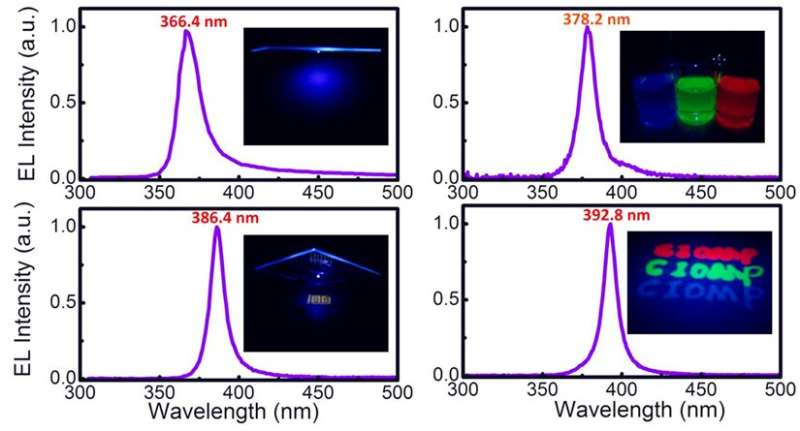Wavelength tunable μC UVOLEDs with asymmetric structural design. Credit: Prof. LIU’s group
Ultraviolet organic light-emitting devices (UVOLEDs) are expected to develop into compact, environmentally friendly and large-size ultraviolet light source applications in analysis, information storage, display, biomedical, etc. However, most of the UV emitted organic materials have broad emission spectra, and thus the electroluminescence (EL) spectra of the most reported UVOLEDs have non-ignorable visible light components, which limits the application prospect of UVOLEDs.
Therefore, the development of narrow band pure UV emission OLED with considerable irradiance and satisfactory durability in practical applications is still a challenge.
In a study published in ACS Appl. Mater. Interfaces, a research group led by Prof. Liu Xingyuan from Changchun Institute of Optics, Fine Mechanics and Physics (CIOMP) of the Chinese Academy of Sciences has developed a high color purity OLED by introducing simple optical structures. The microcavity UVOLEDs (μC UVOLEDs) were constructed by an asymmetric structural design with a specific distributed Bragg reflector (DBR) structure.
The researchers found that the asymmetric microcavity structure can effectively suppress the visible light component, thereby affording narrow-band pure UV emission with tunable wavelength from 366 nm to 400 nm and full width at half maximum (FWHM) of from 9.95 to15.2 nm.
Besides, compared with the reported results, these μCUVOLEDs showed improvement both in irradiance and lifetime owing to the enhanced carrier injection and precise regulation of exciton recombination region in ultrathin microcavity, which can be used to identify the authenticity of RMB.
The improved optoelectronic performance of the μC UVOLEDs indicates that the microcavity effect is useful in achieving the desired narrow peak emission, and the asymmetric structural design also play an important role in improving the overall performances.
This study demonstrated the prototype of μC UVOLEDs for portable compact UV sources, and provided a feasible strategy for the optimal design of narrow band pure UVOLEDs by utilizing simple optical structure.
More information: Jie Lin et al. Highly Efficient Microcavity Organic Light-Emitting Devices with Narrow-Band Pure UV Emission, ACS Applied Materials & Interfaces (2020). DOI: 10.1021/acsami.9b20212
Journal information: ACS Applied Materials and Interfaces
Provided by Chinese Academy of Sciences























